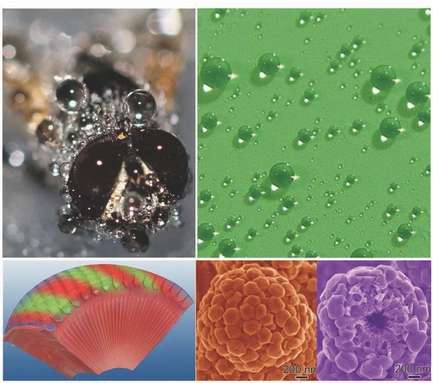Credit: Small, DOI: 10.1002/smll.201400516
(Phys.org) —Researchers working at the University of Wollongong's Institute for Superconducting and Electronic Materials in Australia, along with several Chinese colleagues, have created a superhydrophobic nanostructure material based on microscopic observations of the common green bottle fly. In their paper published in the journal Small, the team describes their work in investigating the fly's eye surface structure, how they found it to be superhydrophobic and then successfully replicated what they'd found using zinc nanoparticles, creating a new material that shows promise for superhydrophobic applications.
Scientists are eager to find materials that are resistant to water bubble formation for application to other materials that are not—the resulting products would be used to coat electronic components to prevent them from breaking down (corroding) due to exposure to moisture. Because such a material would also prevent frost build-up due to freezing fog, other applications could include sprays for airplane wings to prevent ice buildup and clear coatings for car and truck windshields and building windows. Another advantage—since water bubbles cannot form, and because liquids that meet such a surface would slip right off, the material would be self-cleaning as well. Prior research has led to materials that are only semi-effective, and those based on biological examples, such as mosquito eyes have proven to be too difficult to mass produce.
In examining the fly's eye surface structure using a high powered microscope, the researchers found it to be covered with very tiny hexagonal units, each fitted neatly together and just 20 micrometers in diameter. Looking closer, they found that each of the hexagonal units was itself covered in even smaller (100 nanometer) hexagonal units, which unlike the main units protruded up slightly, producing a bubble-like appearance. Putting the fly in a humid environment revealed that that while droplets formed on its body, its eyes remained clear.
Intrigued with their findings, the researchers sought to replicate what they'd found—they used zinc nanoparticles to faithfully recreate what they'd observed in the bottle fly using a two-step self-assembly method. Once complete, the tiny sheet material was tested in the same way as the bottle fly and the researchers report that it was equally superhydrophobic.
The next step will be to create a means for applying the material to various surfaces and then testing how it works to ensure it doesn't cause damage and that it is truly superhydrophobic in real-world applications.
More information: Fly-Eye Inspired Superhydrophobic Anti-Fogging Inorganic Nanostructures, Small, Early View, DOI: 10.1002/smll.201400516 . onlinelibrary.wiley.com/doi/10 … l.201400516/abstract
Abstract
Fly-eye bio-inspired inorganic nanostructures are synthesized via a two-step self-assembly approach, which have low contact angle hysteresis and excellent anti-fogging properties, and are promising candidates for anti-freezing/fogging materials to be applied in extreme and hazardous environments.
Journal information: Small
© 2014 Phys.org






















